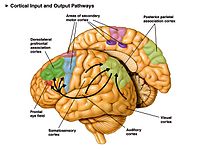
Photo from wikipedia
It is widely recognized that continuous sensory feedback plays a crucial role in accurate motor control in everyday life. Feedback information is used to adapt force output and to correct… Click to show full abstract
It is widely recognized that continuous sensory feedback plays a crucial role in accurate motor control in everyday life. Feedback information is used to adapt force output and to correct errors. While primary motor cortex contralateral to the movement (cM1) plays a dominant role in this control, converging evidence supports the idea that ipsilateral primary motor cortex (iM1) also directly contributes to hand and finger movements. Similarly, when visual feedback is available, primary visual cortex (V1) and its interactions with the motor network also become important for accurate motor performance. To elucidate this issue, we performed and integrated behavioral and electroencephalography (EEG) measurements during isometric compression of a compliant rubber bulb, at 10% and 30% of maximum voluntary contraction, both with and without visual feedback. We used a semi-blind approach (functional source separation (FSS)) to identify separate functional sources of mu-frequency (8-13[Formula: see text]Hz) EEG responses in cM1, iM1 and V1. Here for the first time, we have used orthogonal FSS to extract multiple sources, by using the same functional constraint, providing the ability to extract different sources that oscillate in the same frequency range but that have different topographic distributions. We analyzed the single-trial timecourses of mu power event-related desynchronization (ERD) in these sources and linked them with force measurements to understand which aspects are most important for good task performance. Whilst the amplitude of mu power was not related to contraction force in any of the sources, it was able to provide information on performance quality. We observed stronger ERDs in both contralateral and ipsilateral motor sources during trials where contraction force was most consistently maintained. This effect was most prominent in the ipsilateral source, suggesting the importance of iM1 to accurate performance. This ERD effect was sustained throughout the duration of visual feedback trials, but only present at the start of no feedback trials, consistent with more variable performance in the absence of feedback. Overall, we found that the behavior of the ERD in iM1 was the most informative aspect concerning the accuracy of the contraction performance, and the ability to maintain a steady level of contraction. This new approach of using FSS to extract multiple orthogonal sources provides the ability to investigate both contralateral and ipsilateral nodes of the motor network without the need for additional information (e.g. electromyography). The enhanced signal-to-noise ratio provided by FSS opens the possibility of extracting complex EEG features on an individual trial basis, which is crucial for a more nuanced understanding of fine motor performance, as well as for applications in brain-computer interfacing.
Journal Title: International journal of neural systems
Year Published: 2021
Link to full text (if available)
Share on Social Media: Sign Up to like & get
recommendations!